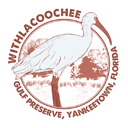Click here to link activity sheet to identify trees at WGP, December 2023 event.
Category Archives: Events
Duck Race Nov., 2023
Image


15th Annual Fundraiser, 2023
Sunday, November 19, 2023, 12:00 noon
On the Withlacoochee River, behind Blackwater Restaurant, 6301 Riverside
Note: $100 flock purchase includes FWGP membership.
Proceeds this year are for boardwalk repair at WGP.
Sponsored by Friends of the Withlacoochee Gulf Preserve


Invasive Plant Survey
 The WGP management plan calls for the periodic survey of the Preserve for invasive plants. Yankeetown was fortunate to have Marc Frank (Extension Botanist, UF/IFAS), Lucas Majure (Curator at UF Herbarium), and several of their colleague and students conduct a survey on October 5, 2018.
The WGP management plan calls for the periodic survey of the Preserve for invasive plants. Yankeetown was fortunate to have Marc Frank (Extension Botanist, UF/IFAS), Lucas Majure (Curator at UF Herbarium), and several of their colleague and students conduct a survey on October 5, 2018.
Accompanied by several of Friends of the WGP and local Master Gardeners the survey team broke into groups and explored the Preserve. The survey found just seven invasive plant species: Brazilian pepper (Schinus terebinthifolius), Chinese tallow tree (Triadica sebifera), Smooth rattlebox (Crotalaria pallida), Lantana (Lantana strigocamara), Springer’s Asparagus Fern (Asparagus aethiopicus), Hairy indigo (Indigofera hirsuta), and Camphor tree (Cinnamomum camphora). None of the invasive plant species were widespread and in several cases consisted of just a single plant. The invasive plant species found were flagged for removal.
In addition, three non-native plant species (Three-flower tick trefoil (Desmodium triflorum), Turk’s turban / Skyrocket (Clerodendrum indicum), and Creeping beggarweed (Desmodium incanum)) were found. While not native to Florida these plants are not currently regarded as invasive. Also observed were several plants (e.g., a cactus and an agave) that to date have not been vouchered in Levy County.
The Board of Trustees and the Friends want to thanks the survey team. We hope to see them again at the Preserve.
Super Blue Blood Moon
 A Super Blue Blood Moon as seen from the Preserve’s Observation Tower. This rare astronomical event triplet happened in the early morning of January 31, 2018.
A Super Blue Blood Moon as seen from the Preserve’s Observation Tower. This rare astronomical event triplet happened in the early morning of January 31, 2018.
A blue moon is the second full moon of a calendar month. The moon rotates around the Earth in a 28-day cycle. So a blue moon happens occasionally. Hence the phrase, “once in a blue moon.”
A super moon happens when the moon is especially close to the Earth, making it appear larger (up to 17%) and brighter than usual. This occurs because the moon’s orbit around the Earth is an ellipse. Which at times brings the moon thousands of miles closer.
Coinciding with the above two events was a total lunar eclipse. As the moon entered Earth’s shadow the reflected light had a reddish tint… a blood moon.
Successful Controlled Burn
The Withlacoochee Gulf Preserve underwent a controlled (prescribed) burn on April 20, 2016. The Yankeetown management plan for the Preserve includes the use of periodic controlled burns. Frequent low-intensity fires are natural phenomena. Fire suppression by man is not. The health of many ecosystems depends on fire. Low-intensity fire promotes new growth and prevents the build up of fuel that could cause a devastating, all consuming, wildfire.
The town of Yankeetown, the WGP Board, and the Friends of the WGP want to thank the Florida Forest Service for a job well done. The result of this successful burn will be a healthier Preserve and a safer Yankeetown community. If you would like to learn more about the burn please watch this video.
Bioblitz at the WGP
The Withlacoochee Gulf Preserve Bioblitz on March 15th & 16th, 2014 was a major success, and a fun, hands on learning experience. The goals of the Bioblitz were to identify flora & fauna and provide a program of expert-led nature walks, kayaking, and presentations. The program included:
by Dr. Linda Tyson (Santa Fe College)
Plant Lore: the History of Florida’s Coastal Flora
by Lars Andersen (Adventure Outpost)
Paddle the Estuary
by Lars Andersen (Adventure Outpost) and UF Students
Birds of the WGP
led by Mary Keith (Tampa Audubon Society/Hillsborough County Extension)
Intro to Plant ID and Plant Walk
by Amy Langston (UF)
Mapping Sea-Level Rise
by Nicholas Digruttolo (UF)
Herpetofauna and Invertebrate Surveys
by Paul Moler (FL FWC)
Botanical Inventory
by Dr. Colette Jacono (UF)
Tidal Creek Seine
by Tom Ankersen (UF), Richard Hamann (UF) and Leroy Creswell (Florida SeaGrant)
WGP Bird Inventory
by Adam and Gina Kent (Avian Research and Conservation Institute)
Intertidal Invertebrate Species Inventory
by Rebecca Squibb and Elliot Hart (UF)
Island Tree Survey
by Dr. David Kaplan (UF)
The WGP BioBlitz was organized by University of Florida Environmental Engineering Professor David Kaplan’s Watershed Ecology Lab. We want to thank them and all who participated in this great two day event.


